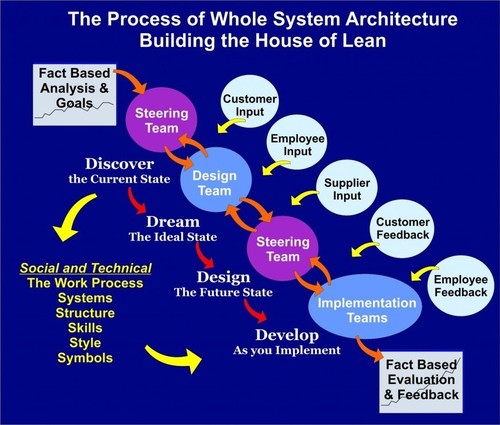Jul 5 2012
Amazon.com: Michel Baudin’s review of Gemba Kaizen, 2nd Edition
See on Scoop.it – lean manufacturing
Includes good case studies, but oversells Kaizen (*** rating on Amazon)
Masaaki Imai is the grand old man who brought the words Kaizen and Gemba into the English language. I did, at some point, work for his company, and was exposed to his ideas then.
Gemba Kaizen has two parts. The first half is a general theory; the second, a series of case studies. Imai’s perspective is that Kaizen is the umbrella concept encompassing all efforts to improve not just factories but all businesses. In his view, TQC/TQM, the Toyota Production System, TPM, Hoshin planning, suggestion systems and small-group activities are all “Kaizen Systems.” It is understandable on Imai’s part, because he first made his mark with a book called Kaizen in the 1980s and called his consulting firm the “Kaizen Institute.”
It is, however, a stretch to make Lean or the Toyota Production System just a “Kaizen System.” Instead, Kaizen is part of what you need to do to implement Lean, but you could not achieve Lean with just Kaizen. Kaizen is continuous, incremental improvements made by those who do the work, and is as necessary as Imai says it is, but it is by no means sufficient, as Lean requires radical changes as well.
The theoretical part contains some valuable information but also overenthusiastic statements such as that the Gemba is the only source of information. Just because the Gemba is too often ignored doesn’t mean that the company’s information systems are useless. They also contain valuable information about customer orders, product configurations, or production history that cannot be inferred just by observing the shop floor.
As is common,the case studies are the most informative part of the book, but they do not necessarily support the premise that the Kaizen concept is central to all improvement. For example, the Production Preparation Process (3P) that is the subject of one of the cases has nothing to do with Kaizen. Some of the stories are also incomplete. The Wiremold case is described through an interview with former CEO Art Byrne, ending with the acquisition of the company by Legrand in 2000. While the post-acquisition epilogue doesn’t make the case for Kaizen, the reader might be interested to know that the new owners sank the company in the following years by reversing what Art Byrne and his team had done.
In conclusion, while I disagree with many of Imai’s ideas, I like to know what they are, and this book serves this purpose.
See on www.amazon.com


Jul 10 2012
Is Lean a Change Methodology or an End State? | Management Meditations
See on Scoop.it – lean manufacturing

Another thoughtful contribution from Larry Miller, with my comments.
See on www.lmmiller.com
Share this:
Like this:
By Michel Baudin • Blog clippings 0 • Tags: Lean, Lean implementation, Management